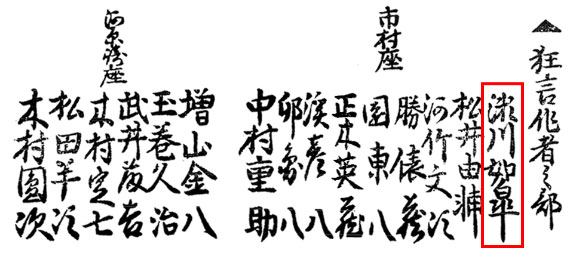| SEGAWA JOKď I |
|
Pen name:
Stage names:
Line number: SHODAI (I) Poetry name: Jok˘ Existence: 1739 ~ 23rd day of the 1st lunar month of 1794 [1] Connection: Father: Ichiyama Shichijűr˘ I (dance master) Master: Segawa Kikunoj˘ II Younger brother: Segawa Senjo Disciple: Komagata Bunz˘ Career: 1739: born in ďsaka in the district of D˘tonbori. He is the son of the dance master Ichiyama Shichijűr˘ I and the elder brother of Ichiyama Shichinosuke. His first stage name was Ichiyama Shichiz˘ I and he is trained to perform as a wakaonnagata. 11th lunar month of 1758: Shichiz˘ performs at the Kado no Shibai in Namiki Sh˘z˘ I's kaomise drama "Arigatashi Fujiwara Keizu", which is produced by Nakayama Bunshichi I. 1st lunar month of 1768: Shichiz˘ goes to Edo. 2nd lunar month of 1768: Shichiz˘ performs at the Ichimuraza in the new year sogamono drama "Shuen Soga ďmu Gaeshi". 1st lunar month of 1769: he becomes disciple of Segawa Kikunoj˘ II, takes the name of Segawa Shichiz˘ and performs at the Nakamuraza in the new year drama "Soga Moy˘ Aigo no Wakamatsu". 5th lunar month of 1774: the drama "Natsu Matsuri Naniwa Kagami" is staged for the first time at the Ichimuraza; Shichiz˘ plays the role of Okaji [casting]. Fall 1775: Shichiz˘ goes back to ďsaka. 12th lunar month of 1775: he takes back the name of Ichiyama Shichiz˘ I, performing at the Higashi no Shibai in the drama "Shiki Utsushi Iroha Butai". Fall 1779: Shichiz˘ goes to Edo. 11th lunar month of 1779: he takes the name of Segawa Otome at the Ichimuraza, performing in the kaomise drama "Azuma no Mori Sakae Kusunoki", which celebrates also the shűmei of Azuma T˘z˘ III. 11th lunar month of 1781: Otome performs at the Nakamuraza in the kaomise program "Shitenn˘ Tonoi no Kisewata". Spring 1783: Otome's rank in the Edo hy˘banki, wakaonnagata section, is j˘-j˘-(shiro)hankichi (superior - superior - (white) half excellent) [visual]. 9th lunar month of 1783: Otome performs at the Nakamuraza in the drama "Buke no Hana Musume no Adauchi", which celebrates the coming departure from Edo of the star Ichikawa Danz˘ IV (onagori ky˘gen). 10th lunar month of 1783: Otome does his final performance (isse ichidai), in Edo at the Nakamuraza, where he performs for 3 days in the dance-drama "Musume D˘j˘ji". 11th lunar month of 1783: he becomes sakusha and takes the name of Segawa Jok˘ I to work at the Nakamuraza. 11th lunar month of 1784: Jok˘ works as a tatesakusha at the Kiriza, along with Takarada Jurai, on the kaomise drama "Jűni Hitoe Komachi Zakura". Premiere of the Nagauta-based dance-drama "Ky˘ran Kumoi no Sode" [2]. Premiere of the dance-drama "Tsumoru Koi Yuki no seki no To" [casting]. 11th lunar month of 1785: Jok˘ works, along with the tatesakusha Kasanui Sensuke I, at the Kiriza on the kaomise drama "Otokoyama Furisode Genji", which celebrates the shűmei of Band˘ Mitsugor˘ II. Premiere of the Tokiwazu-based dance-drama "Shitenn˘ ďe no Yamairi" [3] which is written by Jok˘. 11th lunar month of 1786: Jok˘ works as a tatesakusha at the Moritaza on the kaomise drama "Onna Musha Kiku no Sen'yoki", which celebrates the shűmei of Sawamura Kameemon and Nakamura Kichisabur˘ III. 11th lunar month of 1787: Jok˘ works at the Kiriza on the kaomise drama "Sanga no Sh˘ Mutsu no Hanayome". 11th lunar month of 1788: Jok˘ works at the Ichimuraza, which reopens after a few years of business interruption, on the kaomise drama "Genji Saik˘ Kogane no Tachibana", which celebrates the arrival in Edo of the Kamigata actor Asao Tamejűr˘ I. 11th lunar month of 1790: Jok˘ works at the Ichimuraza on the kaomise drama "Iwao no Hana Mine no Kusunoki". 11th lunar month of 1791: Jok˘ works at the Ichimuraza on the kaomise drama "Kin no Menuki Genke no Kakutsuba", which celebrates the shűmei of Ichikawa Ebiz˘ and Ichikawa Danjűr˘ VI. 11th lunar month of 1792: Jok˘ works at the Ichimuraza on the kaomise drama "Koganegiku Date no ďkido", which celebrates the shűmei of Segawa Yűjir˘ II. 23rd day of the 1st lunar month of 1794 [1]: Jok˘ dies in Edo; his tombstone is located in the precincts of the Daiunji Temple. Comments: Segawa Jok˘ I was a Kabuki actor born and trained in ďsaka. He was active on stages, either in ďsaka or Edo, from 1758 to 1783. He stopped acting and became an Edo sakusha, who worked on more than 30 original dramas or dance-dramas from the first half of the 1780s to the first half of the 1790s. [1] The 23rd day of the 1st lunar month of the 6th year of the Kansei era was the 22nd of February 1794 in the western calendar. [2] This dance-drama is still in the Kabuki repertoire and its common title is "Nakaz˘ Ky˘ran". [3] This dance-drama is still in the Kabuki repertoire and its common title is "Yamanba".
The name of Segawa Jok˘ I in a 1792 Edo hy˘banki (the name within the red box); all the names were the sakusha at the Ichimuraza The Segawa Jok˘ line of playwrights |
|
|
| Contact | Main | Top | Updates | Actors | Plays | Playwrights | Programs | Links | FAQ | Glossary | Chronology | Illustrations | Prints | Characters | Derivatives | Theaters | Coming soon | News |
